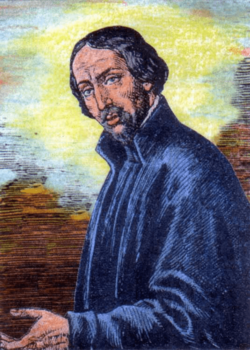Henry Morse facts for kids
Quick facts for kids SaintHenry Morse S.J. |
|
|---|---|
 |
|
| Priest and Martyr | |
| Born | c. 1595 Brome, Suffolk, England |
| Died | 1 February 1645 (aged 49 - 50) Tyburn, London, England |
| Venerated in | Roman Catholic Church |
| Beatified | 15 December 1929, Rome by Pope Pius XI |
| Canonized | 25 October 1970, Rome by Pope Paul VI |
| Major shrine | St. Henry Morse RC Church, Diss |
| Feast | 1 February; 25 October (as part of the 40 Martyrs) |
Henry Morse (born around 1595 – died February 1, 1645) was a brave English priest. He is known as one of the Forty Martyrs of England and Wales. These are people who died for their Catholic faith in England.
Contents
Henry Morse's Early Life and Studies
Henry Morse was born in 1595 in a place called Brome, in Suffolk, England. He was born into a Protestant family. His father, Robert Morse, owned a small amount of land.
When Henry was 16, he started studying law. He went to Corpus Christi College, Cambridge and then to Gray's Inn in London.
Becoming a Catholic Priest
In 1614, Henry's father passed away. Henry then traveled to France to meet his brother, William. William was studying to become a priest. While in France, Henry decided to become a Catholic. This happened at the English College, Douay.
He went back to England to sort out some money matters. But he was arrested in Dover. This was because he refused to take an oath of loyalty to the King. This oath went against his new Catholic faith. He was then put in Southwark prison.
Henry Morse's Time in Prison
Henry stayed in prison with other priests for four years. In 1618, King James I of England set many priests free. He wanted to make a deal for his son, Prince Charles, to marry a Spanish princess.
After being freed, Henry went back to Douai. He then went to the English College, Rome in Rome to continue his studies. To keep his identity secret from the English government, he used the name "Henry Claxon."
Working as a Missionary
Henry became a priest in Rome. In 1624, he went back to England to help the Catholic community. He was sent to Newcastle-upon-Tyne. A terrible disease called the plague broke out there. Henry and other priests bravely helped the sick.
The next year, he was arrested again. He was moved from Newcastle Gaol to York Castle. Even in prison, he continued to care for the sick. While in prison, he officially became a Jesuit priest. After three years, he was sent out of the country. He then worked as a missionary for English and Irish soldiers in the Spanish army.
Return to England and Final Arrest
At the end of 1633, Henry returned to London. He worked in the St Giles-in-the-Fields area. In 1635, the plague came to London. Henry caught the illness while helping others, but he got better. He worked with another priest, John Southworth. They raised money for food and medicine for those suffering.
On February 27, 1636, he was arrested again and put in Newgate prison. He was accused of being a priest and turning people away from the King's faith. He was found guilty of being a priest.
Release and Exile
On June 20, 1637, Henry was released from prison. This happened because Queen Henriette Maria insisted on it. To protect the people who had helped him get out, he chose to leave England. This was when the King ordered all priests to leave the country. He became a chaplain for an English army group serving Spain.
In 1643, Henry came back to England. After about a year and a half, he was arrested again. He was held in Durham and Newcastle. Then he was sent by sea to London.
Henry Morse's Martyrdom
On January 30, 1645, Henry was brought to court again. He was sentenced to death based on his earlier conviction.
On February 1, 1645, Henry Morse was taken to Tyburn to be executed. The French ambassador and other important people were there to watch. Henry was allowed to die before his body was cut into pieces. Many people, including the French ambassador's servants, dipped their handkerchiefs in his blood. This showed their respect for him.
Henry Morse was recognized as a saint. He was beatified in 1929 and then made one of the Forty Martyrs of England and Wales in 1970.
In 2012, a new Catholic church was built in Diss and named after Saint Henry Morse.

